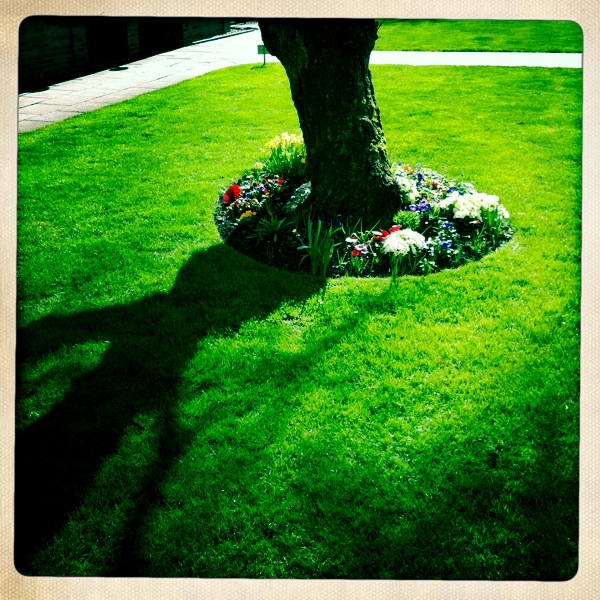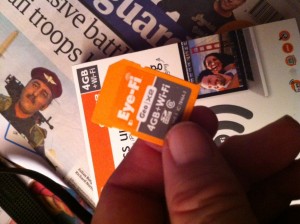Category Archives: Photography
OK: which way?
Apocalypse Now!
Peeping through
Spotted on a lovely evening walk the other day.
Gigapixels
The BBC has published an extraordinary high-res photograph of the London crowds gathered to see the Middleton-Windsor merger celebrations.
Woodland glade
Seen on a walk yesterday.
Lilac
The ‘End of History’ Man — on photography
A story about associative linking that would make Ol’ Vannevar Bush proud.
I’ve been reading reviews of Francis Fukuyama’s new book The Origins of Political Order: From Prehuman Times to the French Revolution and wondering whether to buy it. It looks interesting. And then I came on a Newsweek photo essay about him which included an intriguing photograph of him with his camera case. That’s when I discovered that he was a serious photographer, so of course I then went looking for his pictures, but before I got to any I found this essay by him on WSJ.com.
Let’s begin with how photography has changed. Ansel Adams’s iconic images of the Sierras were taken with an 8-inch-by-10-inch view camera, a wooden contraption with bellows in which the photographer saw his subject upside-down and reversed under a black cloth. Joel Meyerowitz’s stunning photographs of Cape Cod were taken with a similar mahogany Deardorff view camera manufactured in the 1930s. These cameras produce negatives that contain up to 100 times the amount of information produced by a contemporary top-of-the-line digital SLR like a Canon EOS 5D or a Nikon D3. View cameras allow photographers to shift and tilt the lens relative to the film plane, which is why they continue to be used by architectural photographers who want to avoid photos of buildings with the converging vertical lines caused by the upward tilt of the lens on a normal camera. And their lenses can be stopped down to f/64 or even f/96, which allows everything to be in crystalline focus from 3 inches away to infinity. (Ansel Adams, Edward Weston and Imogen Cunningham were part of a group called “f/64” in celebration of this characteristic.)
Perhaps the most important feature of these older film cameras was their lack of convenience. They had to be mounted on tripods; it took many minutes to shoot a single frame; and they were hardly inconspicuous. In contrast to contemporary digital photographers who snap a zillion photos of the same subject and hope that one will turn out well composed, view camera photography is a more painterly activity that forces the photographer to slow down and think ahead carefully about subject, light, framing, time of day, and the like. These skills are in short supply among digital photographers.
Older cameras were far better built. A few years ago I was given a Leica M3 once owned by my uncle, who joined the U.S. Army to get out of an internment camp for Japanese-Americans during World War II. He was sent to Germany where he acquired the Leica around the time I was born. This camera, with its f/2 Summicron, a classic, fast, tack-sharp lens, still takes beautiful pictures. How many digital cameras will still be functioning five years from now, much less 50? Where are you going to buy new batteries and the media to store your photos in 2061?
Where indeed? It turns out that Fukuyama is also an audio buff with strong views on the capacity of MP3 compression to ruin audio quality.
And of course I had to check out what a GigiPan Epic 100 would cost. Answer: £414 on eBAY.
Eye-Fi
Ten years ago if you said that I would like to have an Internet-connected camera I’d have said you were nuts. But acquiring an iPhone changed my view: I’ve found it really useful to be able to upload pictures from anywhere at any time without having to be tethered to a computer. The iPhone camera isn’t great, but as the man said the best camera is always the one you have with you, and I always have the phone. But it’d be nice to be able to have instant uploads from a better camera.
Enter Eye-Fi, an SD card which can talk to a wireless network from inside your camera. I bought one from Amazon for just under £70 — which is expensive for an SD card, but what the hell. You install some software on PC or laptop, register with Eye-Fi, put the card into your camera and — Bingo! Images are automatically uploaded. You can link your account to other services like Flickr and Facebook. And the card can do geolocation based on Wi-Fi network location.
Sounds too good to be true? In a way, it is. The system works fine, but uploads are slow unless one constrains the size and quality of the images. For shooting and uploading web-friendly jpegs it works fine: in fact it might be a good way of getting stuff in near-real-time onto Flickr. But you can’t use the full range of image quality and size available on a decent camera. So it’s got its applications, but it looks as though the iPhone camera will still find plenty of use.
It’s also got lots of embarrassing potential. Suppose, for example, you were careless with the upload settings: you might find that a set of, er, intimate pictures were attracting an admiring audience to your Flickr account or Facebook page. And, then of course, there’s this.
Hipstory
Very interesting blog by a war photographer who has found his iPhone to be a useful casual camera. Some of his images, though technically crude, are very powerful — especially the shot of the feet of a civilian casualty in the Benghazi morgue.
This blog is part of a project borne during my travels as a professional photojournalist. For years, I have worked with bulky digital cameras, always mindful of the technical maneuvers from setting the shutter speed and aperture to editing and toning on a computer screen. In the last two years I have discovered that my iPhone has allowed me to capture scenes without feeling that I am once again on the job. To “point and shoot” has been a liberating experience. It has allowed me to rediscover the excitement of seeing imperfections and happy accidents rendered through the lens of my handheld device. I am able to create imagery, edit, and transmit all the images straight to this blog, creating a modern and efficient workflow for the most inefficient of pursuits – self expression.
The Hipstamatic App must seem weird to non-photographers — a digital app that makes digital images look like they’d been taken by a Kodak Brownie. A cynic would call it retro chic, but there’s more to it than that. See, for example, this picture of mine, snapped in a speeding train.







